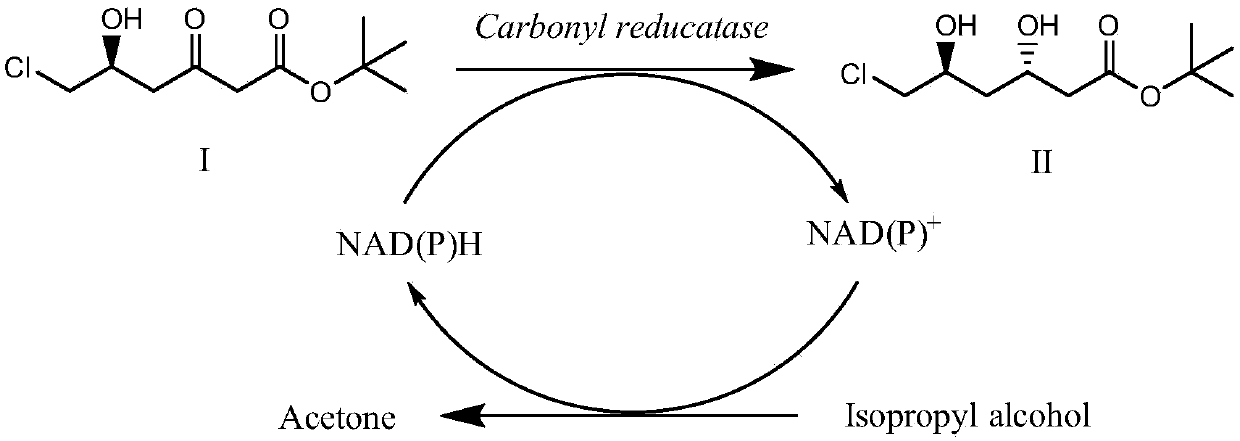Carbonyl reductase genetically-engineered bacteria immobilized cells and application thereof
A technology of genetically engineered bacteria and immobilized cells, applied to methods based on microorganisms, biochemical equipment and methods fixed on or in inorganic carriers, can solve the problems of low substrate concentration, poor stability, and resistance to organic solvents. Poor acceptability and other problems, to achieve the effects of high product yield and purity, reduction of "three wastes" emissions, and simplification of process steps
- Summary
- Abstract
- Description
- Claims
- Application Information
AI Technical Summary
Problems solved by technology
Method used
Image
Examples
Embodiment 1
[0024] Embodiment 1: Activated carbon pretreatment
[0025] Activated carbon (purchased from Shanghai Lingfeng Chemical Reagent Co., Ltd., pharmaceutical grade) was sieved through a 40-mesh sieve. Weigh 10 g of sieved activated carbon and add it to 100 mL of 1M hydrochloric acid, and stir at 50°C for 1 h. Suction filtration, wash the activated carbon with distilled water and rinse until the filtrate is close to neutral (pH value is 6.9-7.1), put the activated carbon into an oven to dry, that is, 10 g of pretreated activated carbon, and store it for later use.
Embodiment 2
[0026] Embodiment 2: the cultivation of carbonyl reductase genetic engineering bacteria cell
[0027] (1) Construction of carbonyl reductase genetically engineered bacteria:
[0028] Primer 1 (CCG CATATG ACTGATCGTTTAAAAG), Primer 2 (TTG CTCGAG TTATTGAGCAGTGTATCC), and Nde I and Xho I restriction enzyme sites (underlined) were introduced into primer 1 and primer 2, respectively. Using the genomic DNA of Lactobacillus parabuchneri as a template, under the priming of primer 1 and primer 2, high-fidelity Pfu DNA polymerase was used for PCR amplification to obtain the carbonyl reductase CR1 gene sequence, which was sequenced using Nde The amplified fragment was treated with I and Xho I restriction enzymes (TaKaRa) and ligated with the commercial vector pET28b (Invitrogen) treated with the same restriction enzymes using T4 DNA ligase (TaKaRa) , to construct the expression vector pET28b-CR1 ( Liu Z-Q, et al. Biotechnology Progress, 2017, DOI 10.1002 / btpr.2460. )( image 3 ). ...
Embodiment 3
[0030] Example 3: Immobilization of Carbonyl Reductase Genetically Engineered Bacteria Cells
[0031] Potassium phosphate salt (K 2 HPO 4 -KH 2 PO 4 ) buffer solution (molar concentration is 100mM), weigh 100g of the carbonyl reductase genetically engineered bacterium wet thallus prepared by the method in Example 2 and add it to 1L, pH 7.0, 100mM potassium phosphate buffer solution to obtain 1L of bacterial suspension. Accurately weigh 18g (dry weight) of activated carbon (18g / L) pretreated in Example 1 and add it to 1L of bacterial suspension for mixing. At room temperature (20-30°C) and 500rpm, stir and adsorb with a water bath stirring paddle for 30min; Then add 40mL of 5% polyethyleneimine aqueous solution (according to 4% of the total system volume 1L), at room temperature, 500rpm, stir and cross-link with a water bath stirring blade for 1h; then add 30mL of 50% glutaraldehyde aqueous solution (according to 3% of the total system volume 1L added), at room temperature,...
PUM
 Login to View More
Login to View More Abstract
Description
Claims
Application Information
 Login to View More
Login to View More - Generate Ideas
- Intellectual Property
- Life Sciences
- Materials
- Tech Scout
- Unparalleled Data Quality
- Higher Quality Content
- 60% Fewer Hallucinations
Browse by: Latest US Patents, China's latest patents, Technical Efficacy Thesaurus, Application Domain, Technology Topic, Popular Technical Reports.
© 2025 PatSnap. All rights reserved.Legal|Privacy policy|Modern Slavery Act Transparency Statement|Sitemap|About US| Contact US: help@patsnap.com



